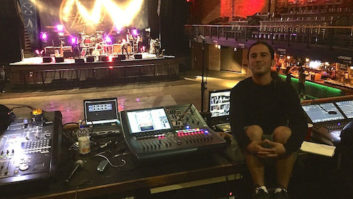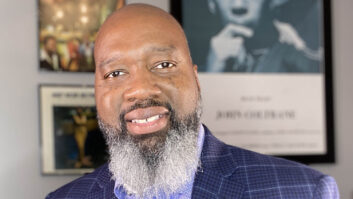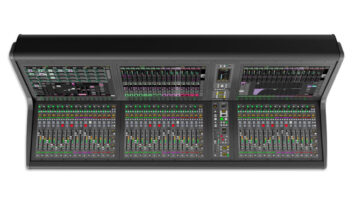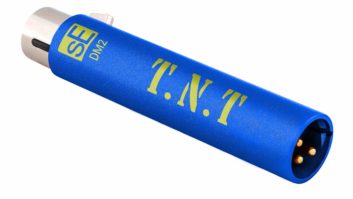
sE Electronics’ reputation for creating microphones offering quality beyond their price has been buzzing in the industry for a while now. sE makes its own capsules, which are built and tuned by hand; then, tubes and other components are specially selected. The X1 T reviewed here is the tube version of the company’s X1 large-diaphragm studio microphone. In a sidebar, I also review the sE SPACE Reflexion Filter, a portable acoustic control and isolation unit for use in challenging and noisy environments.
Out of the Box
The X1 T is a great looking microphone. It ships with a hard-shell case, separate power supply, quality 7-pin connector, 15-foot cable and mic clip. I also received the sE isolation pack that contains a windscreen and shock-mount (sold separately).
The X1 T is a cardioid, tube microphone with a built-in -10dB pad and highpass filter starting at 100 Hz (down -3dB at 60 Hz). The microphone is fatter than most tube mics, having its own distinctive, wide shape, and will not fit into most other shock-mounts. The construction of the metal chassis feels solid and is finished with a special acoustic-damping rubberized paint to help with chassis resonance. The mesh grille contains two different types of weave, and I had issues with the grille being softer than I am used to. In my experience, when placing the X1 T into its shock-mount, I needed to hold the grille portion in order to slide the mic in and secure the base. Because of its softness, the grille can become bent and dented rather easily.
I tested the X1 T using a Great River MP-2NV preamp through a vintage Ashly SC55, then an Apogee A/D into Sequoia recording at 96 kHz. Monitoring was through a Mytek Stereo192-DSD D/A into Neumann KH monitors.
The first recording involved a Guild solid-wood acoustic, with maple sides and back. The X1 T gave a full and up-front sound. In comparison with a few of my favorite large-diaphragm mics, the X1 T definitely had a boost to the low-midrange in the 150 to 225Hz range. The cardioid pattern was wide enough to capture a balance of tones, much like the AT4050 we used in comparison. Compared to an ADK A51TC Tube condenser, which costs three times the price, the X1 T’s tone was much fuller in the low-midrange but less airy on top. The ADK was more even and had a silky sheen that the X1 T did not exhibit. I used the X1 T on a few sessions where I needed the extra fullness that this microphone provides.
I then tried the X1 T on vocals, and as with any vocal microphone, it really depends on the voice. Overall the mic was full and rich sounding, and always upfront. I found that it really shined on male rap vocals. The low-end fullness mixed with its bump in the 4kHz range worked perfectly to set the vocals boldly in a mix. The same held true for voice-overs. The HPF worked well here in conjunction with the low-midrange tone of the mic.
I did not have such good results using the Isolation Pack. The shock-mount for the X1 T is large and plastic, and the windscreen mounts to the shock-mount. If the singer touches the shock-mount, the handling noise is evident in the signal path. My test for shock-mounts has always been to set up the mic for recording, and then jump up and down in the room to see how much vibration is transmitted all the way to the capsule. Using the sE shock-mount, there was the same amount of rumble compared to not using one at all. I then mounted the X1 T in a shock-mount that comes free with a $69 MXL budget microphone and the rumble was drastically reduced. I found the windscreen to be lacking as well, easily letting through plosives.
At $399 street, the X1 T is a great deal. I would recommend this microphone to anyone needing a fat-sounding, upfront microphone for VO work or vocals needing an LF presence with an edge in the 4kHz vocal range. The Isolation Pack provides a good fitting shock-mount but I was not thrilled with its performance.
Tim Dolbear is an audio engineer and producer at Eclectica Studios in Austin, Texas.
Product Summary
COMPANY: sE Electronics
PRODUCT: X1 T
WEBSITE:www.seelectronics.com
PRICE: $399
PROS: Warm, full and upfront. The price.
CONS: Does not fit well in third-party shock-mounts. Delicate grille
sE SPACE Reflexion Filter
sE has been building various models of reflection filters for years.
SPACE is large and needs a firm and solid mic stand. Its newly designed mounting hardware not only mounts SPACE to the stand, but also holds the microphone.
In the first test I wanted to see how SPACE isolated the microphone from room noise. I set up in the control room at Eclectica Studios with all the equipment, computers and the Mini Split AC unit running. I set the proper recording level on the Great River mic pre so my voice would peak at my standard -10 dB. The AC unit is very quiet, and together with the computer fan noise brought up the control room’s noise floor by 6 dB at the mic’s position. With the microphone mounted by itself, Sequoia’s Peak/RMS metering showed a noise floor of -62.8 dB. With the SPACE setup, the noise floor dropped to 66 dB.
Next, I set up inside a 90-degree corner made of glass. Speaking into the corner produces a flood of reflections back to the performer’s position. Recording the X1T without the SPACE yielded the expected results: a lively hollowness to my voice. I added the SPACE back to the stand and recorded the voice-over part again. The result was fantastic. My voice was focused, and the reflections were no longer captured. My voice also regained its fullness and clarity—definition returned to the recording, along with the polished quality of an announcer. I did not realize how much tone was missing from my voice until I compared it to the version using SPACE. Bravo!







